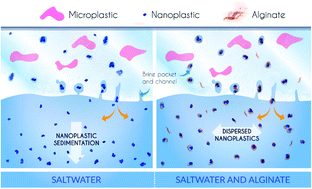Micro- and nanoplastic transfer in freezing saltwater: implications for their fate in polar waters†
Abstract
Plastic debris accumulates in the Arctic by way of oceanic and atmospheric circulation. High concentrations of microplastics (1 μm to 5 mm) have been measured, and nanoplastics (<1 μm) are expected to be abundant as well. However, little is known about the mobility of micro- and nanoplastics at the seawater/ice interface. This study investigates the fate of micro- and nanoplastics during sea-ice formation. A novel experimental approach simulates the growth of sea ice by progressively freezing a saline solution. After different durations of freezing, the concentrations of NaCl, natural organic matter, microplastics, and nanoplastics were measured in the ice and liquid. Micro- and nanoplastic distribution coefficients between saltwater and ice were determined, reflecting their behavior during congelation sea-ice growth. The results show that microplastics are retained in ice while nanoplastics are expulsed from it. Furthermore, natural organic matter plays a crucial role in stabilizing nanoplastics at this interface. These results raise new questions concerning the impact of micro- and nanoplastics in fragile polar environments and the analytical strategy to detect them.

- This article is part of the themed collection: SDG14: Life Below Water – Marine Litter (Plastics and Pollution)


 Please wait while we load your content...
Please wait while we load your content...